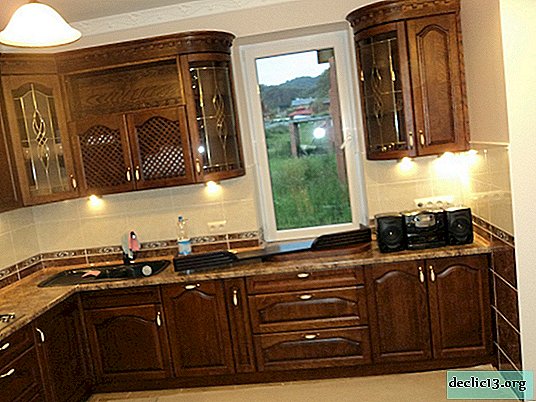Tender Beauty - Blue Nile Rose

The Blue Nile stands out among other rose varieties with its original bud color and unforgettable aroma.
Gardeners consider it unpretentious, but long magnificent flowering can be achieved only with proper care.
In the article, we will clearly see what the Blue Nile rose looks like. From the text we learn the history of the emergence of this variety, in which it differs from the other species, and also consider how to use a rose in landscape design.
Detailed description
Blue Nile belongs to the tea-hybrid varieties and is included in a special color group of blue roses. Upright bushes are able to reach a height of 150 cm, a width of 70 cm. The shape and size of the plant depends on the pruning and region of habitat.The shoots are covered with spikes. The leaves are large, dark green. Soft rounded petals have a lavender-blue color. Hue varies depending on the stage of dissolution of the bud, as well as on lighting. At different times of the day you can see pink, lilac, purple overflows.
Flowers appear on the stem one at a time, sometimes 2 or 3 and stay on the bushes for a long time. Terry flowers with a diameter of up to 12 cm. Rose has a strong aroma with a combination of citrus, fruit and tea notes.
Grade advantages:
- Elegant flower shape.
- Unusual coloring.
- Pleasant, catchy aroma.
- Roses are not only suitable for decorating the garden, but also used for cutting.
- Widespread use in landscape design.
- High winter hardiness.
Disadvantages:
- A lot of spikes.
- Due to the average resistance to disease, prevention is required.
- In the rain, the buds may not open.
- In regions with harsh winters, shelter is needed.
Let's review a brief overview of the Blue Nile rose variety:
Photo
Next, we suggest that you familiarize yourself with the photo of the plant.




History of occurrence
The variety was bred by breeder Delbar in 1981 in France. Registered in the USA in the same year.
What is the difference from the rest of the species?
The Blue Nile has an original petal color that lasts the entire flowering period and does not fade in the sun, unlike most roses. The rose blooms before the snow and is very fragrant.
Bloom
When and how?
With proper care, the Blue Nile blooms profusely from June to early November, without interruptions.
Before and after care: features
- Before the formation of buds, potassium-phosphorus fertilizers are used. At the stage of ovary formation, top dressing is carried out with organic matter - chicken droppings or mullein. During the flowering period, fertilizers containing potassium, magnesium, sulfur, and phosphorus are applied. In the fall - 2 top dressings with phosphorus, nitrogen and potassium.
- The first buds on the seedlings are cut so that the root system develops better.
- From spring to the end of flowering, the bushes are abundantly watered, then the intensity of the procedures is reduced, focusing on weather conditions.
What to do if it does not bloom?
 If the bush refuses to bloom, it is important to identify negative factors and adjust the conditions of detention.
If the bush refuses to bloom, it is important to identify negative factors and adjust the conditions of detention.
The formation and opening of buds may be hindered by:
- nutrient deficiency;
- excess nitrogen;
- improper watering;
- insufficient lighting;
- lack of trimming, incorrect trimming;
- diseases and pests.
Use in landscape design
Roses of this variety can be used in different styles of landscape. They look great both in single and in group planting among the lawn, as well as in mixborders - in composition with other plants. Roses Blue Nile successfully combined with pink, blue and yellow-green tones.
Step-by-step care instructions
- Choosing a landing place.
The Rose Blue Nile is ideally suited to a well-lit area that falls into partial shade in the daytime bright sun. A prerequisite is adequate air circulation and protection against drafts. It is better to place the flower on a hill to avoid stagnation of water and decay of the root system. It is advisable to plant a rose next to tall bushes or buildings.
Important! Neighborhood with raspberries, cherries, pears and mountain ash is not recommended. - What should be the soil?
It requires loose fertile soil with high acidity, pH 5.6-7.3. If groundwater is close, it is necessary to organize drainage of pebbles, sand and broken bricks.
- Planting by seed.
For propagating roses, the seed method is not used, otherwise plants that do not have the properties of this variety are obtained.
 Temperature.
Temperature.The optimum temperature in the summer lies in the range from + 18 ° С to + 25 ° С. The maximum temperature is + 30 ° C, the minimum is -35 ° C.
- Watering.
Roses of the Blue Nile need to be watered rarely, but abundantly, not allowing the land to dry out. One watering per week is enough. Water consumption per bush is 3-5 liters. Use water at room temperature. In arid, hot weather, watering is increased to 2 times a week.
During the procedure, they try not to get on the leaves and buds, so as not to provoke the development of fungal diseases. The best time for the event is evening hours. After each irrigation, carefully loosen the soil. In autumn, after flowering is completed, watering is stopped until spring.
- Top dressing.
In the first year after planting, fertilizing the soil is not required. Starting from the second year, feeding is carried out:
- In spring, pruning and watering the ground.
- They bring dry mineral fertilizers, digging with them the earth around the bush.
- Water the soil.
- After a week, they are fed organic fertilizers.
- Fertilize every 30-50 days. In September, the last top dressing for the season is carried out.
- Pruning.
In early spring, before the buds awaken, damaged, dried and frozen shoots are removed. In the northern climate, shoots are cut to 70 cm, in the southern - up to 150 cm. During the summer, wilted flowers are cut with a small shoot area. In autumn, in preparation for winter, damaged, broken and too long branches are cut.
 Transfer.
Transfer. Prepare the site. Dig the ground. Use the purchased land or form the soil mixture yourself according to the following recipe:
- Mullein - 3 parts;
- fertile soil - 2 parts;
- sand - 2 parts;
- peat - 1 part.
Procedure:
- Dig a hole half a meter deep. Pour fertilized soil to the bottom. Remove the rose from the soil, rinse the roots with water.
- Place the plant in a pit, add ground.
- Water and spud.
- Preparing for the winter.
The variety is resistant to frost, but for the winter the bushes must be covered. After pruning, plants are spudded, covered with dry foliage, spruce spruce branches and non-woven material.
How to propagate?
The best option is to purchase quality seedlings in a nursery or botanical garden. Seedlings are bought in the spring. Landing is carried out in soil heated by the sun at a temperature of at least + 18 ° C.
- Before planting, the roots of the seedling are dipped in water with the addition of a growth stimulator for 4-6 hours.
- In the selected area, a recess is dug 2-3 times the size of the root system.
- A drainage layer is placed at the bottom.
- A layer of soil mixture is poured on top to the middle of the pit volume.
- Damaged roots and weak shoots are cut off on the seedling, healthy ones are shortened.
- Set the seedling in the ground.
- They add it with nutrient soil. Tamp the soil a little.
- Watered.
Diseases and Pests
 Rose has an average degree of resistance to powdery mildew and gray rot. It is necessary to regularly carry out preventive measures. In the spring, with the appearance of leaves, spraying with a soda solution is done twice a week: 40 g of soda per 1 liter of water.
Rose has an average degree of resistance to powdery mildew and gray rot. It is necessary to regularly carry out preventive measures. In the spring, with the appearance of leaves, spraying with a soda solution is done twice a week: 40 g of soda per 1 liter of water.
The procedures are carried out until the end of June. Or they treat the bushes with Bordeaux liquid in the spring, after removing the shelter, and in preparation for the winter.
To prevent fungal diseases, roses are recommended to be grown in open sunny areas with good air circulation.
In case of an attack of gray aphids, an infusion of soap solution with wormwood is prepared.
- Grate a piece of laundry soap. Chips are poured into a bucket with 10 liters of water.
- Several branches of wormwood are added to the solution. Boil the product for 15 minutes, insist and filter.
- Spray shoots once a week until the pests are eliminated.
If the measures taken do not give positive results, the bush is treated with insecticides. If you follow the basic rules for caring for a Blue Nile rose, you can enjoy abundant flowering from June to the most frosts. Bushes, studded with buds of an unusual shade, look great in the garden, and bouquets of cut flowers successfully decorate any interior.

 Temperature.
Temperature. Transfer.
Transfer. 















